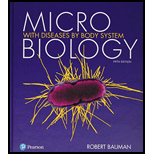
Concept explainers
1.
To determine:
The disease that the doctor should suspect and the infectious agent causes this disease.
Concept introduction:
Disease is defined as an abnormal condition of the body that disrupts important physical and physiological function of the body. Disease is caused by improper diet, lack of exercise, various infectious agents that are present in nature, toxic substances, genetic disorders, and depression, stress play a role in illness and disturbs normal functioning of the body.
2.
To determine:
How did student most likely to contract the disease.
Concept introduction:
Disease is defined as an abnormal condition of the body that disrupts important physical and physiological function of the body. Disease is caused by improper diet, lack of exercise, various infectious agents that are present in nature, toxic substances, genetic disorders, and depression, stress play a role in illness and disturbs normal functioning of the body.
3.
To determine:
What are the other symptoms student might develop.
Concept introduction:
Disease is defined as an abnormal condition of the body that disrupts important physical and physiological function of the body. Disease is caused by improper diet, lack of exercise, various infectious agents that are present in nature, toxic substances, genetic disorders, and depression, stress play a role in illness and disturbs normal functioning of the body.
4.
To determine:
What causes the symptoms of disease and why does his girlfriend not display same symptom.
Concept introduction:
Disease is defined as an abnormal condition of the body that disrupts important physical and physiological function of the body. Disease is caused by improper diet, lack of exercise, various infectious agents that are present in nature, toxic substances, genetic disorders, and depression, stress play a role in illness and disturbs normal functioning of the body.
5.
To determine:
How should the student be treated.
Concept introduction:
Disease is defined as an abnormal condition of the body that disrupts important physical and physiological function of the body. Disease is caused by improper diet, lack of exercise, various infectious agents that are present in nature, toxic substances, genetic disorders, and depression, stress play a role in illness and disturbs normal functioning of the body.
Want to see the full answer?
Check out a sample textbook solution
Chapter 21 Solutions
Pearson eText Bauman Microbiology with Diseases by Body Systems -- Instant Access (Pearson+)
- What is the result of the acid-fast stain below: Stock Images by Getty Images by Getty Images by Getty Images by Getty Image Getty Images St Soy Getty Images by Getty Images by Getty Images Joy Getty encapsulated O endosporulating negative ○ positivearrow_forwardYou have a stock vial of diligence 75mg in 3ml and need to draw up a dose of 50mg for your patient.how many mls should you draw up to give this dosearrow_forwardYou are recquired to administer 150mg hydrocortisone intravenously,how many mls should you give?(stock =hydrocortisone 100mg in 2mls)arrow_forward
- If someone was working with a 50 MBq F-18 source, what would be the internal and external dose consequences?arrow_forwardWe will be starting a group project next week where you and your group will research and ultimately present on a current research article related to the biology of a pathogen that infects humans. The article could be about the pathogen itself, the disease process related to the pathogen, the immune response to the pathogen, vaccines or treatments that affect the pathogen, or other biology-related study about the pathogen. I recommend that you choose a pathogen that is currently interesting to researchers, so that you will be able to find plenty of articles about it. Avoid choosing a historical disease that no longer circulates. List 3 possible pathogens or diseases that you might want to do for your group project.arrow_forwardnot use ai pleasearrow_forward
- DNK dagi nukleotidlar va undan sintezlangan oqsildagi peptid boglar farqi 901 taga teng bo'lib undagi A jami H boglardan 6,5 marta kam bo'lsa DNK dagi jami H bog‘lar sonini topingarrow_forwardOne of the ways for a cell to generate ATP is through the oxidative phosphorylation. In oxidative phosphorylation 3 ATP are produced from every one NADH molecule. In respiration, every glucose molecule produces 10 NADH molecules. If a cell is growing on 5 glucose molecules, how much ATP can be produced using oxidative phosphorylation/aerobic respiration?arrow_forwardIf a cell is growing on 5 glucose molecules, how much ATP can be produced using oxidative phosphorylation/aerobic respiration?arrow_forward
 Medical Terminology for Health Professions, Spira...Health & NutritionISBN:9781305634350Author:Ann Ehrlich, Carol L. Schroeder, Laura Ehrlich, Katrina A. SchroederPublisher:Cengage LearningUnderstanding Health Insurance: A Guide to Billin...Health & NutritionISBN:9781337679480Author:GREENPublisher:Cengage
Medical Terminology for Health Professions, Spira...Health & NutritionISBN:9781305634350Author:Ann Ehrlich, Carol L. Schroeder, Laura Ehrlich, Katrina A. SchroederPublisher:Cengage LearningUnderstanding Health Insurance: A Guide to Billin...Health & NutritionISBN:9781337679480Author:GREENPublisher:Cengage- Health Safety And Nutrition F/Young ChildHealth & NutritionISBN:9781305144767Author:MAROTZPublisher:Cengage





